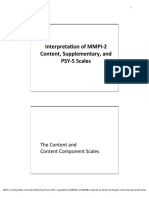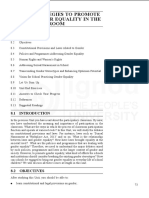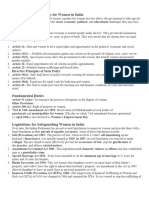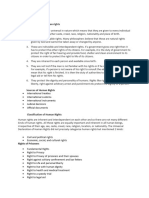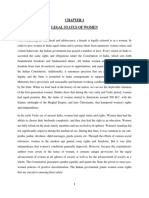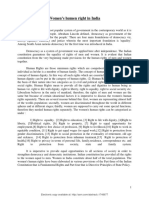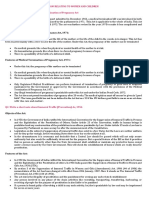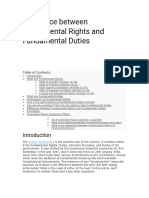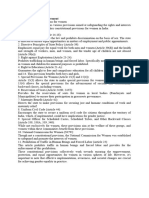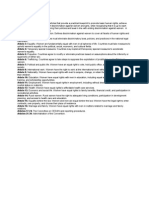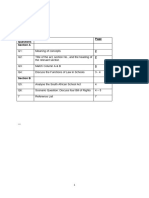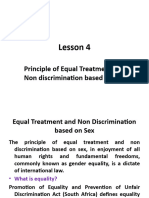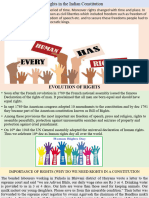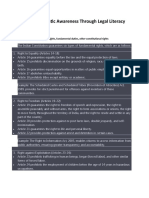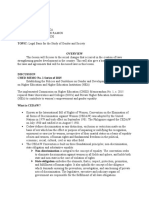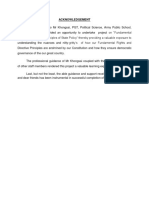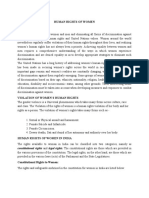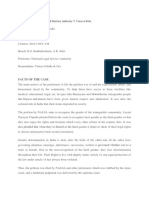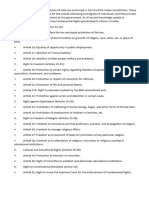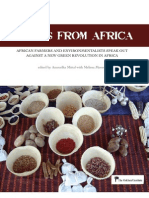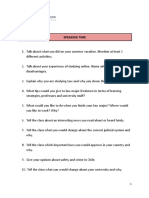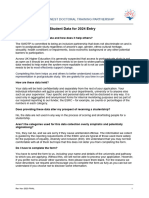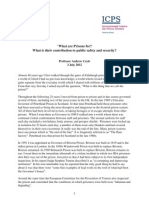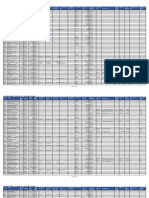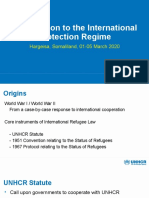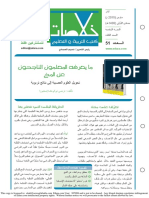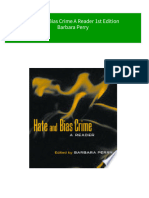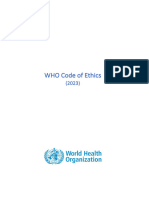0 ratings0% found this document useful (0 votes)
1 viewsGender justice final notes unit 2
Gender justice final notes unit 2
Uploaded by
ashwanipratap997very important notes
Copyright:
© All Rights Reserved
Available Formats
Download as PDF, TXT or read online from Scribd
Gender justice final notes unit 2
Gender justice final notes unit 2
Uploaded by
ashwanipratap9970 ratings0% found this document useful (0 votes)
1 views26 pagesvery important notes
Copyright
© © All Rights Reserved
Available Formats
PDF, TXT or read online from Scribd
Share this document
Did you find this document useful?
Is this content inappropriate?
very important notes
Copyright:
© All Rights Reserved
Available Formats
Download as PDF, TXT or read online from Scribd
Download as pdf or txt
0 ratings0% found this document useful (0 votes)
1 views26 pagesGender justice final notes unit 2
Gender justice final notes unit 2
Uploaded by
ashwanipratap997very important notes
Copyright:
© All Rights Reserved
Available Formats
Download as PDF, TXT or read online from Scribd
Download as pdf or txt
You are on page 1of 26
Gender justice UNIT 2
Ques-1 Provisions relating to women in UDHR.
Ans- The Universal Declaration of Human Rights (UDHR) has
several provisions that relate to women's rights. Here are
some of the key provisions:
# Article 1: Equality and Non-Discrimination
- All human beings are born free and equal in dignity and
rights.
- This article sets the tone for the rest of the declaration,
emphasizing the importance of equality and non-
discrimination.
# Article 2: Non-Discrimination
- Everyone is entitled to all the rights and freedoms set forth
in the declaration, without distinction of any kind, including
sex.
- This article explicitly prohibits discrimination on the basis of
sex.
# Article 16: Right to Marriage and Family
- Men and women of full age have the right to marry and to
found a family.
- This article recognizes the right to marriage and family, and
ensures that women have equal rights in this regard.
# Article 23: Right to Work
- Everyone has the right to work, to free choice of
employment, and to equal pay for equal work.
- This article recognizes the right to work and ensures that
women have equal access to employment and equal pay for
equal work.
# Article 25: Right to an Adequate Standard of Living
- Everyone has the right to a standard of living adequate for
the health and well-being of themselves and their family.
- This article recognizes the right to an adequate standard of
living, which is particularly important for women who may be
disproportionately affected by poverty.
# Article 26: Right to Education
- Everyone has the right to education.
- This article recognizes the right to education, which is
essential for women's empowerment and equality.
These provisions in the UDHR provide a foundation for
promoting and protecting women's rights, and have been
influential in shaping international human rights law and
policy.
Ques-2 Provisions relating to women in International
covenant on civil and political rights 1966.
Ans- The International Covenant on Civil and Political Rights
(ICCPR) 1966 has several provisions that relate to
women'srights. Here are some of the key provisions
# Article 2: Non-Discrimination
Equality Before the Law: The article ensures that everyone,
including women, is equal before the law and is entitled to
equal protection of the law.
Prohibition of Discrimination: The article prohibits
discrimination on the basis of sex, among other grounds.
# Article 3: Equal Rights of Men and Women
Equal Rights: The article ensures that men and women have
equal rights to enjoy all civil and political rights.
# Article 6: Right to Life
Protection from Violence: The article protects the right to
life, which is particularly important for women who may be
at risk of violence and abuse.
# Article 7: Freedom from Torture
Protection from Torture: The article protects the right to
freedom from torture and cruel, inhuman, and degrading
treatment or punishment.
# Article 9: Right to Liberty
Protection from Arbitrary Arrest: The article protects the
right to liberty and security of person, which is particularly
important for women who may be at risk of arbitrary arrest
and detention.
# Article 23: Protection of the Family- Protection of the
Family: The article recognizes the importance of the family
and ensures that men and women have equal rights and
responsibilities within the family.
# Article 26: Equality Before the Law
Equality Before the Law: The article ensures that everyone,
including women, is equal before the law and is entitled to
equal protection of the law.
These provisions in the ICCPR provide a framework for
promoting and protecting women's rights, and have been
influential in shaping international human rights law and
policy.
Ques-3 Provisions relating to women in Economic
social and cultural rights 1966.
Ans- The International Covenant on Economic, Social
and Cultural Rights (ICESCR) 1966 has several
provisions that relate to women's rights. Here are
some of the key provisions:
# Article 2: Non-Discrimination
* Equality Before the Law: The article ensures that
everyone, including women, is equal before the law
and is entitled to equal protection of the law.
* Prohibition of Discrimination: The article prohibits
discrimination on the basis of sex, among other
grounds.
# Article 3: Equal Rights of Men and Women : The
article ensures that men and women have equal rights
to enjoy all economic, social, and cultural rights.
# Article 7: Right to Fair Conditions of Work
* Equal Pay for Equal Work: The article ensures that
men and women have equal pay for equal work.
* Safe and Healthy Working Conditions: The article
ensures that men and women have safe and healthy
working conditions.
# Article 10: Protection of the Family
* Protection of the Family: The article recognizes the
importance of the family and ensures that men and
women have equal rights and responsibilities within
the family.
* Special Protection for Women: The article provides
special protection for women, including paid maternity
leave and protection from dismissal during pregnancy
or maternity leave.
# Article 11: Right to an Adequate Standard of Living
* Right to Adequate Food: The article ensures that
everyone, including women, has the right to adequate
food.
* Right to Adequate Housing: The article ensures that
everyone, including women, has the right to adequate
housing.
# Article 12: Right to Physical and Mental Health
* Right to Health: The article ensures that everyone,
including women, has the right to the highest
attainable standard of physical and mental health.
* Access to Healthcare: The article ensures that
everyone, including women, has access to healthcare
services.
These provisions in the ICESCR provide a framework for
promoting and protecting women's economic, social,
and cultural rights.
Ques-4 Commission on Status of women.
Ans- The Commission on the Status of Women (CSW) is a
functional commission of the United Nations Economic and
Social Council (ECOSOC), dedicated to promoting gender
equality and the empowerment of women.
Mandate and Objectives
* Promoting Women's Rights: The CSW promotes women's
rights and gender equality globally.
* Monitoring Progress: The commission monitors progress
towards achieving gender equality and the empowerment of
women.
* Setting Global Standards: The CSW sets global standards
and policies to promote gender equality and women's
empowerment.
Structure and Membership
1. Membership: The CSW has 45 member states, elected by
ECOSOC for a four-year term.
2. Bureau: The commission is headed by a bureau,
comprising a chairperson and four vice-chairpersons.
3. Secretariat: The CSW secretariat is provided by the United
Nations Division for the Advancement of Women.
Key Activities and Initiatives
1. Annual Sessions: The CSW holds annual sessions to discuss
pressing issues related to gender equality and women's
empowerment.
2. Agreed Conclusions: The commission adopts agreed
conclusions, which provide policy guidance and
recommendations to governments and other stakeholders.
3. Review and Appraisal: The CSW reviews and appraises
progress towards achieving gender equality and women's
empowerment.
4. Beijing Platform for Action: The CSW played a key role in
the development and implementation of the Beijing Platform
for Action, a landmark agreement on gender equality and
women's empowerment.
Impact and Achievements
1. Promoting Gender Equality: The CSW has played a crucial
role in promoting gender equality and women's
empowerment globally.
2. Setting Global Standards: The commission has set global
standards and policies to promote gender equality and
women's empowerment.
3. Empowering Women: The CSW has empowered women
and girls by promoting their rights, education, and economic
empowerment.
Ques-5 Declaration on elimination of discrimination against
women 1967.
Ans- The Declaration on the Elimination of Discrimination
against Women (DEDAW) was adopted by the United Nations
General Assembly in 1967. This declaration is a key
international instrument that aims to eliminate
discrimination against women and promote gender equality.
# Key Provisions
1. Article 1: Defines discrimination against women and
emphasizes the importance of eliminating such
discrimination.
2. Article 2: Calls on states to condemn discrimination
against women and to pursue policies to eliminate it.
3. Article 3: Emphasizes the importance of education in
eliminating discrimination against women.
4. Article 4: Calls on states to eliminate laws, regulations,
and customs that discriminate against women.
5. Article 5: Emphasizes the importance of equal rights for
women in marriage and family relations.
6. Article 6: Calls on states to eliminate discrimination
against women in the economic and social fields.
7. Article 7: Emphasizes the importance of equal rights for
women in the political field.
8. Article 8: Calls on states to eliminate discrimination
against women in the field of education.
9. Article 9: Emphasizes the importance of equal rights for
women in the field of employment.
10. Article 10: Calls on states to eliminate discrimination
against women in the field of health.
11. Article 11: Emphasizes the importance of equal rights for
women in the field of social security.
# Significance
The Declaration on the Elimination of Discrimination against
Women (DEDAW) is significant because it:
1. Establishes a framework: For eliminating discrimination
against women and promoting gender equality.
2. Sets standards: For states to follow in eliminating
discrimination against women.
3. Provides a basis: For further international action to
promote women's rights and gender equality.
The DEDAW has been influential in shaping international
human rights law and policy, particularly in the area of
women's rights. It has also served as a foundation for
subsequent international instruments, such as the
Convention on the Elimination of All Forms of Discrimination
against Women (CEDAW) in 1979.
Ques-6 Convention on the elimination of all forms of
discrimination against women, 1979 (CEDAW).
Ans- The Convention on the Elimination of All Forms of
Discrimination against Women (CEDAW), adopted in 1979, is
an international treaty that aims to eliminate all forms of
discrimination against women.
Key Provisions
1. Definition of Discrimination: CEDAW defines discrimination
against women as any distinction, exclusion, or restriction
made on the basis of sex that has the effect or purpose of
impairing or nullifying the recognition, enjoyment, or
exercise by women of human rights and fundamental
freedoms.
2. State Obligations: States parties to CEDAW are obligated
to:
* Take all appropriate measures to eliminate
discrimination against women.
* Ensure that women have equal rights with men in all
fields.
* Establish tribunals and other public institutions to
protect women's rights.
3. Substantive Equality: CEDAW recognizes that women's
equality requires not only formal equality but also
substantive equality.
4. Temporary Special Measures: CEDAW allows for
temporary special measures to be taken by States parties to
accelerate the achievement of equality between men and
women.
Structure
1. Preamble: The preamble sets out the purpose and
objectives of the convention.
2. Articles 1-6: These articles define discrimination against
women, outline state obligations, and provide for the
establishment of a committee to monitor implementation.
3. Articles 7-16: These articles address specific areas of
concern, including education, employment, healthcare, and
family law.
Impact and Significance
1. International Framework: CEDAW provides an
international framework for promoting women's rights and
eliminating discrimination against women.
2. State Accountability: CEDAW holds States parties
accountable for their obligations to eliminate discrimination
against women.
3. Empowering Women: CEDAW has empowered women to
claim their rights and participate fully in society.
4. Influence on National Laws: CEDAW has influenced the
development of national laws and policies to promote
women's rights and eliminate discrimination against women.
Ques-7 Committee on elimination of discrimination against
women.
Ans- The Committee on the Elimination of Discrimination
against Women (CEDAW Committee) is a body of
independent experts that monitors the implementation of
the Convention on the Elimination of All Forms of
Discrimination against Women (CEDAW).
Composition and Membership
1. 23 Members: The CEDAW Committee consists of 23
independent experts, elected by the States parties to
CEDAW.
2. Expertise: Members are elected based on their expertise in
women's rights, human rights, and related fields.
3. Independence: Members serve in their personal capacity,
independent of their governments.
Mandate and Functions
1. Monitoring Implementation: The CEDAW Committee
monitors the implementation of CEDAW by States parties.
2. Reviewing State Reports: The committee reviews reports
submitted by States parties on their implementation of
CEDAW.
3. Conducting Inquiries: The committee can conduct inquiries
into situations of grave or systematic violations of women's
rights.
4. Providing General Recommendations: The committee
issues general recommendations to States parties on the
implementation of CEDAW.
5. Considering Individual Complaints: The committee can
consider individual complaints of violations of women's rights
under the Optional Protocol to CEDAW.
Working Methods
1. State Reporting: States parties submit reports on their
implementation of CEDAW.
2. Constructive Dialogue: The committee engages in
constructive dialogue with States parties during the review
of their reports.
3. General Recommendations: The committee issues general
recommendations to States parties on the implementation
of CEDAW.
4. Inquiries and Investigations: The committee can conduct
inquiries and investigations into situations of grave or
systematic violations of women's rights.
Impact and Significance
1. Promoting Women's Rights: The CEDAW Committee has
promoted women's rights and gender equality globally.
2. Holding States Accountable: The committee has held
States parties accountable for their obligations under
CEDAW.
3. Empowering Women: The CEDAW Committee has
empowered women to claim their rights and participate fully
in society.
Ques-8 The optional protocol to the convention of
elimination of all forms of discrimination against women.
Ans- The Optional Protocol to the Convention on the
Elimination of All Forms of Discrimination against Women
(OP-CEDAW) is an international human rights instrument that
aims to strengthen the protection of women's rights under
CEDAW.
Key Provisions
1.Individual Complaints: The OP-CEDAW allows individuals or
groups of individuals to submit complaints to the CEDAW
Committee alleging violations of women's rights under
CEDAW.
2. Inquiry Procedure: The OP-CEDAW establishes an inquiry
procedure that allows the CEDAW Committee to investigate
situations of grave or systematic violations of women's rights.
3. Interim Measures: The OP-CEDAW allows the CEDAW
Committee to request interim measures to prevent harm or
further violations of women's rights.
Objectives
1. Strengthen Protection: To strengthen the protection of
women's rights under CEDAW.
2. Provide Remedies: To provide remedies for women whose
rights have been violated.
3. Promote Accountability: To promote accountability of
States parties for their obligations under CEDAW.
Benefits
1. Empowering Women: The OP-CEDAW empowers women
to claim their rights and seek remedies for violations.
2. Strengthening Accountability: The OP-CEDAW strengthens
accountability of States parties for their obligations under
CEDAW.
3. Promoting Gender Equality: The OP-CEDAW promotes
gender equality by addressing the specific needs and
concerns of women.
Challenges and Limitations
1. Limited Access: Limited access to information and
resources can hinder women's ability to submit complaints
under the OP-CEDAW.
2. State Resistance: Some States parties may resist or fail to
implement the recommendations of the CEDAW Committee.
3. Limited Remedies: The OP-CEDAW provides limited
remedies for women whose rights have been violated.
Ques-9 First world conference on status of women, Mexico
1975- World plan of action.
Ans-The First World Conference on the Status of Women was
held in Mexico City, Mexico, from June 19 to July 2, 1975. The
conference was convened by the United Nations General
Assembly to assess the status of women worldwide and to
develop strategies for promoting women's rights and
equality.
Key Outcomes
1. World Plan of Action: The conference adopted the World
Plan of Action, a comprehensive document outlining
strategies for promoting women's rights and equality.
2. United Nations Decade for Women: The conference
launched the United Nations Decade for Women (1976-
1985), a global campaign to promote women's rights and
equality.
3. Establishment of UNIFEM: The conference led to the
establishment of the United Nations Development Fund for
Women (UNIFEM), now known as UN Women.
World Plan of Action
The World Plan of Action is a comprehensive document that
outlines strategies for promoting women's rights and
equality. The plan focuses on three main areas:
1. Education and Training: The plan emphasizes the
importance of education and training for women, particularly
in areas such as literacy, vocational training, and leadership
development.
2. Employment and Health: The plan addresses the need for
equal opportunities for women in employment and health,
including access to healthcare, family planning, and social
security.
3. Participation in Decision-Making: The plan emphasizes the
importance of women's participation in decision-making at
all levels, including government, politics, and community
organizations.
Impact and Legacy
The First World Conference on the Status of Women and the
World Plan of Action had a significant impact on promoting
women's rights and equality globally. The conference:
1. Raised Awareness: The conference raised awareness about
the status of women worldwide and the need for action to
promote women's rights and equality.
2. Established a Global Agenda: The World Plan of Action
established a global agenda for promoting women's rights
and equality, which has guided international efforts in this
area.
3. Inspired National and Local Action: The conference
inspired national and local action to promote women's rights
and equality, including the establishment of national
machineries for women and women's organizations.
Ques-10 Third world conference on women Nairobi 1985
Narobi forward looking strategies.
Ans-The Third World Conference on Women was held in
Nairobi, Kenya, from July 15 to 26, 1985. The conference was
convened by the United Nations to review progress made
since the previous conferences and to develop strategies for
promoting women's rights and equality.
Key Outcomes
1. Nairobi Forward-Looking Strategies: The conference
adopted the Nairobi Forward-Looking Strategies, a
comprehensive document outlining strategies for promoting
women's rights and equality.
2. Global Strategy: The conference adopted a global strategy
to promote women's rights and equality, focusing on areas
such as education, employment, healthcare, and
participation in decision-making.
3. Establishment of UNIFEM: The conference led to the
establishment of the United Nations Development Fund for
Women (UNIFEM), now known as UN Women.
Nairobi Forward-Looking Strategies
The Nairobi Forward-Looking Strategies is a comprehensive
document that outlines strategies for promoting women's
rights and equality. The document focuses on three main
areas:
1. Equality: The document emphasizes the importance of
achieving equality between men and women in all areas of
life.
2. Development: The document highlights the need for
women's participation in development and the importance of
addressing the specific needs and concerns of women.
3. Peace: The document emphasizes the importance of
promoting peace and reducing violence against women.
Key Recommendations
1. Education and Training: The document recommends
increasing access to education and training for women,
particularly in areas such as literacy, vocational training, and
leadership development.
2. Employment and Economic Empowerment: The document
recommends promoting equal opportunities for women in
employment and economic empowerment, including access
to credit, land, and other resources.
3. Health and Well-being: The document recommends
improving access to healthcare and promoting women's
health and well-being, particularly in areas such as
reproductive health and violence against women.
Impact and Legacy
The Third World Conference on Women and the Nairobi
Forward-Looking Strategies had a significant impact on
promoting women's rights and equality globally. The
conference:
1. Raised Awareness: The conference raised awareness about
the status of women worldwide and the need for action to
promote women's rights and equality.
2. Established a Global Agenda: The Nairobi Forward-Looking
Strategies established a global agenda for promoting
women's rights and equality, which has guided international
efforts in this area.
3. Inspired National and Local Action: The conference
inspired national and local action to promote women's rights
and equality, including the establishment of national
machineries for women and women's organizations.
Ques-11 The Fourth World conference on women,
Beijing,1995-Beijing platform for action-critical areas, steps
to be taken.
Ans- The Fourth World Conference on Women was held in
Beijing, China, from September 4 to 15, 1995. The conference
was convened by the United Nations to review progress
made since the previous conferences and to develop
strategies for promoting women's rights and equality.
Beijing Platform for Action
The Beijing Platform for Action is a comprehensive document
that outlines strategies for promoting women's rights and
equality. The document identifies 12 critical areas of
concern and outlines specific steps to be taken to address
these concerns.
Critical Areas of Concern
1. Women and Poverty: Eliminating poverty and promoting
economic empowerment for women.
2. Education and Training: Promoting equal access to
education and training for women.
3. Women and Health: Improving women's health and well-
being, particularly in areas such as reproductive health and
violence against women.
4. Violence Against Women: Eliminating violence against
women, including domestic violence, sexual harassment, and
trafficking.
5. Women and Armed Conflict: Protecting women and girls
from the effects of armed conflict and promoting their
participation in peace-building and conflict resolution.
6. Women and the Economy: Promoting equal opportunities
for women in the economy, including access to credit, land,
and other resources.
7. Women in Power and Decision-Making: Increasing
women's participation in power and decision-making,
including in government, politics, and other areas.
8. Institutional Mechanisms: Strengthening institutional
mechanisms for promoting women's rights and equality,
including national machineries for women and women's
organizations.
9. Human Rights: Promoting women's human rights,
including the right to equality, dignity, and freedom from
violence and discrimination.
10. Women and the Media: Promoting positive and non-
stereotypical portrayals of women in the media.
11. Women and the Environment: Promoting women's
participation in environmental decision-making and
addressing the impact of environmental degradation on
women.
12. The Girl Child: Promoting the rights and well-being of the
girl child, including access to education, healthcare, and
protection from violence and exploitation.
Steps to Be Taken
The Beijing Platform for Action outlines specific steps to be
taken to address the critical areas of concern. These steps
include:
1. Policy and Legislative Reforms: Governments should enact
and enforce laws and policies that promote women's rights
and equality.
2. Institutional Mechanisms: Governments should establish
and strengthen institutional mechanisms for promoting
women's rights and equality.
3. Education and Training: Governments should provide
education and training programs that promote women's
empowerment and equality.
4. Community Participation: Governments should involve
communities in promoting women's rights and equality.
5. International Cooperation: Governments should cooperate
internationally to promote women's rights and equality.
Impact and Legacy
The Fourth World Conference on Women and the Beijing
Platform for Action had a significant impact on promoting
women's rights and equality globally. The conference:
1. Raised Awareness: The conference raised awareness about
the status of women worldwide and the need for action to
promote women's rights and equality.
2. Established a Global Agenda: The Beijing Platform for
Action established a global agenda for promoting women's
rights and equality, which has guided international efforts in
this area.
3. Inspired National and Local Action: The conference
inspired national and local action to promote women's rights
and equality, including the establishment of national
machineries for women and women's organizations.
Ques-12 World conference on Human Rights at
Vienna,1993-Declaration on Elimination of violence against
women,1993.
Ans- World Conference on Human Rights, Vienna 1993
Background
The World Conference on Human Rights was held in Vienna,
Austria, from June 14 to 25, 1993. The conference was
attended by representatives from 171 countries, as well as
non-governmental organizations (NGOs) and other
stakeholders.
Objectives
The main objectives of the conference were:
1. To review the progress made in the field of human rights
since the adoption of the Universal Declaration of Human
Rights in 1948.
2. To identify the challenges and obstacles to the promotion
and protection of human rights.
3. To develop strategies and recommendations for the
promotion and protection of human rights.
Outcomes
The conference resulted in the adoption of the Vienna
Declaration and Programme of Action, which:
1. Emphasized the universality, indivisibility, and
interdependence of human rights.
2. Recognized the importance of promoting and protecting
the rights of vulnerable groups, including women, children,
and indigenous peoples.
3. Called for the establishment of national human rights
institutions and the strengthening of international human
rights mechanisms.
Declaration on the Elimination of Violence against Women,
1993-The Declaration on the Elimination of Violence against
Women was adopted by the UN General Assembly in 1993, in
response to the growing recognition of violence against
women as a human rights issue.
Definition of Violence against Women
The declaration defines violence against women as:
"Any act of gender-based violence that results in, or is likely
to result in, physical, sexual or psychological harm or
suffering to women, including threats of such acts, coercion
or arbitrary deprivation of liberty, whether occurring in
public or in private life."
Forms of Violence against Women
The declaration identifies several forms of violence against
women, including:
1. Physical, sexual, and psychological violence.
2. Domestic violence.
3. Sexual harassment.
4. Rape.
5. Mutilation.
6. Forced marriage.
7. Forced prostitution.
State Obligations
The declaration outlines the obligations of states to:
1. Prevent violence against women.
2. Investigate and punish acts of violence against women.
3. Provide protection and support services to victims of
violence against women.
4. Promote education and awareness-raising about violence
against women.
Impact and Legacy
The Declaration on the Elimination of Violence against
Women has had a significant impact on the promotion and
protection of women's rights, particularly in the area of
violence against women. It has:
1. Raised awareness about the issue of violence against
women.
2. Provided a framework for states to develop policies and
laws to prevent and respond to violence against women.
3. Inspired the development of national and international
mechanisms to address violence against women.
You might also like
- Solution To Question Bank of Law Relating To Women and ChildrenDocument74 pagesSolution To Question Bank of Law Relating To Women and Childrencofey44729No ratings yet
- Hserv 579 Structural Racism 2020-21Document43 pagesHserv 579 Structural Racism 2020-21api-545982271No ratings yet
- 5 MMPI 2 Content Supplementary PSY5 FinalDocument29 pages5 MMPI 2 Content Supplementary PSY5 Finalmemo leyNo ratings yet
- Vagina Monologues Programme - Queen MaryDocument4 pagesVagina Monologues Programme - Queen Maryahgillett0% (1)
- Lesson Plan - Detecting The Mood Disorder FinalDocument2 pagesLesson Plan - Detecting The Mood Disorder FinalTrixie MizonaNo ratings yet
- Strategies To Promote Gender Equality in ClassroomDocument19 pagesStrategies To Promote Gender Equality in ClassroomPriyanka GusainNo ratings yet
- Constitutional Provisions For Women in India: Directive Principles of State PolicyDocument4 pagesConstitutional Provisions For Women in India: Directive Principles of State Policylexalliance.sunilkumarNo ratings yet
- Q: - 1 Characteristics of Human RightsDocument16 pagesQ: - 1 Characteristics of Human Rightssakshi duttaNo ratings yet
- Women and Child RightsDocument4 pagesWomen and Child Rightsganesh yadavNo ratings yet
- Women EmpowermentDocument17 pagesWomen Empowermentshagun sharmaNo ratings yet
- Labour Law - ExplainerDocument8 pagesLabour Law - Explaineranmolsingla305No ratings yet
- Genesis of Feminist JurisprudenceDocument36 pagesGenesis of Feminist JurisprudenceDavid TonsingNo ratings yet
- Women's Human RightsDocument24 pagesWomen's Human Rightsnouf khanNo ratings yet
- Overview of International Legal Frameworks For Disability LegislationDocument92 pagesOverview of International Legal Frameworks For Disability LegislationTamnna SharmaNo ratings yet
- ashishDocument6 pagesashishabhineetgoswami032003No ratings yet
- Legal Status of WomenDocument24 pagesLegal Status of WomenNeetaNo ratings yet
- Legal Status of WomenDocument96 pagesLegal Status of WomenNeetaNo ratings yet
- Women's Human Rights (Kindly Ignore The Wrong Spelling of Human in The OcumentDocument11 pagesWomen's Human Rights (Kindly Ignore The Wrong Spelling of Human in The OcumentfaarehaNo ratings yet
- Gsoc111 Prelim NotesDocument18 pagesGsoc111 Prelim Noteskel.fontanoza04No ratings yet
- International Covenants of 1966Document7 pagesInternational Covenants of 1966vaishnavi kapsikarNo ratings yet
- Law Related To Womens - DCQDocument39 pagesLaw Related To Womens - DCQStuff And SpamNo ratings yet
- Ganeshram ICDocument10 pagesGaneshram ICmaretiganeshramNo ratings yet
- International MandatesDocument27 pagesInternational MandatesdarrelhatesyouNo ratings yet
- Majlis Legal Rights of WomenDocument76 pagesMajlis Legal Rights of WomenLavanya100% (1)
- Unit 5Document6 pagesUnit 5luisfurtado110No ratings yet
- Constitutional Provisions For Gender JusticeDocument6 pagesConstitutional Provisions For Gender JusticeVilasini RajeshNo ratings yet
- Cases DPSP and FRDocument58 pagesCases DPSP and FRAkshat KulshresthaNo ratings yet
- Significant Chapter in The Country's Political Development. Here's AnDocument18 pagesSignificant Chapter in The Country's Political Development. Here's AnKanishka AryaNo ratings yet
- Rangita de Silva de AlwisDocument6 pagesRangita de Silva de AlwislaysajaroNo ratings yet
- Cedaw SummaryDocument1 pageCedaw SummaryVanny Gimotea BaluyutNo ratings yet
- EDCC 514 2020 Assignment 1Document9 pagesEDCC 514 2020 Assignment 1Jacqueline LeshageNo ratings yet
- CEDAWDocument10 pagesCEDAWMario SantosNo ratings yet
- Lesson 4Document23 pagesLesson 4dengdenismayenNo ratings yet
- Icescr Final by SandeepDocument25 pagesIcescr Final by Sandeepsandybhai1No ratings yet
- Human Rights & Social WorkDocument52 pagesHuman Rights & Social WorkShaan IshmaelNo ratings yet
- Coi MSTDocument17 pagesCoi MSTPartima JainNo ratings yet
- International Covenant On Civil & Political Rights (ICCPR)Document5 pagesInternational Covenant On Civil & Political Rights (ICCPR)priyaNo ratings yet
- Protection of Vulnerable GroupsDocument17 pagesProtection of Vulnerable Groupskishu vermaNo ratings yet
- Rights in The Indian ConstitutionDocument26 pagesRights in The Indian ConstitutionShe ShineNo ratings yet
- CEDAWDocument11 pagesCEDAWDhruv SharmaNo ratings yet
- SEC-2 Democratic Awareness Through Legal LiteracyDocument12 pagesSEC-2 Democratic Awareness Through Legal LiteracyDon Badsa100% (1)
- Final Seminar Course 1Document9 pagesFinal Seminar Course 1msblazee21No ratings yet
- Gender Justice and Human Rights Jan 31stDocument10 pagesGender Justice and Human Rights Jan 31stamit dipankarNo ratings yet
- Lesson 6 Human Rights Peace IntegrationDocument10 pagesLesson 6 Human Rights Peace IntegrationjordancassandraantonioNo ratings yet
- UNIT - 1 Introduction To ConstitutionDocument6 pagesUNIT - 1 Introduction To Constitutiondipg9316No ratings yet
- Gender Justice in The Indian ConstitutionDocument8 pagesGender Justice in The Indian ConstitutionKarandeep100% (2)
- Group-1 GENDER AND SOCIETYDocument4 pagesGroup-1 GENDER AND SOCIETYMarivic MiradorNo ratings yet
- CH 1Document10 pagesCH 1pranjalivashiNo ratings yet
- Constitutional LawDocument16 pagesConstitutional LawKhalil AhmadNo ratings yet
- Ihr Group 5Document14 pagesIhr Group 5Christine KanyangoNo ratings yet
- Objects and Utility of Study of Gender JusticeDocument3 pagesObjects and Utility of Study of Gender Justicedeeproy0315No ratings yet
- Eod Human Right Unit-3Document21 pagesEod Human Right Unit-3mayank SharmaNo ratings yet
- Political Science ProjectDocument11 pagesPolitical Science ProjectKamakshi BhandariNo ratings yet
- HR of WomenDocument6 pagesHR of WomenPranzalNo ratings yet
- Untitled document - Google DocsDocument10 pagesUntitled document - Google Docsmsblazee21No ratings yet
- Case Commentary Sehajpreet KaurDocument7 pagesCase Commentary Sehajpreet KaurSehajpreet KaurNo ratings yet
- Child Rights in The Constitution of IndiaDocument21 pagesChild Rights in The Constitution of IndiaMunish DograNo ratings yet
- Human Rights Part 2. 4thDocument4 pagesHuman Rights Part 2. 4thtayyebtayyeb626No ratings yet
- Women and Child LawDocument5 pagesWomen and Child LawDeepak ChauhanNo ratings yet
- The Fundamental Rights of Citizens of India Are Enshrined in Part III of The Indian ConstitutionDocument2 pagesThe Fundamental Rights of Citizens of India Are Enshrined in Part III of The Indian ConstitutionMIRZA IBRAHIM ALI BAIGNo ratings yet
- Arpana 23 WCLDocument14 pagesArpana 23 WCLSamta KumariNo ratings yet
- IJCRT2111036Document6 pagesIJCRT2111036Kulzum FatimaNo ratings yet
- Bureau Sureleve: –French Constitution– FranceFrom EverandBureau Sureleve: –French Constitution– FranceNo ratings yet
- Ancient History Source of Law 1SEMDocument30 pagesAncient History Source of Law 1SEMashwanipratap997No ratings yet
- IJRPR1569Document5 pagesIJRPR1569ashwanipratap997No ratings yet
- Major Achievements of The Ministry During Last Eight YearsDocument54 pagesMajor Achievements of The Ministry During Last Eight Yearsashwanipratap997No ratings yet
- Doctrines Constitution of India Doct Doctrine of Colourable Legislation Print 2Document1 pageDoctrines Constitution of India Doct Doctrine of Colourable Legislation Print 2ashwanipratap997No ratings yet
- LGBTQ CultureDocument8 pagesLGBTQ Cultureapi-308583630No ratings yet
- Reading Response #2Document4 pagesReading Response #2kevin morenoNo ratings yet
- Incident Report TemplateDocument2 pagesIncident Report TemplateCHURCHEL BERBERNo ratings yet
- Mass Incarceration and Economic InequalityDocument4 pagesMass Incarceration and Economic InequalityJustice Policy InstituteNo ratings yet
- AGRA Voices From Africa - FullDocument45 pagesAGRA Voices From Africa - Fulluri880No ratings yet
- Human Rights - Unit 1 - Legal English IVDocument11 pagesHuman Rights - Unit 1 - Legal English IVAlonso ChávezNo ratings yet
- SWDTP Equal Opps For 2024 EntryDocument3 pagesSWDTP Equal Opps For 2024 EntryKhushi NadgaudaNo ratings yet
- Unit 10: Family and Social Issues: Speaking at PECDocument4 pagesUnit 10: Family and Social Issues: Speaking at PECHà ĐoànNo ratings yet
- What Are Prisons For? What Is Their Contribution To Public Safety and Security?Document8 pagesWhat Are Prisons For? What Is Their Contribution To Public Safety and Security?jailhouselawyerNo ratings yet
- Diplomatic MissionDocument1 pageDiplomatic MissionSometimes goodNo ratings yet
- Pre-Bail Hearing Room DataDocument155 pagesPre-Bail Hearing Room DataLydian CoombsNo ratings yet
- POLITIK HUKUM PIDANA - PPTX S1 PDFDocument42 pagesPOLITIK HUKUM PIDANA - PPTX S1 PDFSlamet SuhartoNo ratings yet
- MQ 54976Document159 pagesMQ 54976Ash KeyNo ratings yet
- Diversity and Spatial Difference in The CityDocument45 pagesDiversity and Spatial Difference in The CityLeobert Yancy Salosagcol100% (1)
- 02 Introduction To The International Protection RegimeDocument14 pages02 Introduction To The International Protection RegimeYasir OsmanNo ratings yet
- Indemnity Form Release 1 PDFDocument1 pageIndemnity Form Release 1 PDFWilliam CahyadiNo ratings yet
- ما يعرفه المعلمون الناجحون عن المخ تحويل العلوم العصبية إلى نتائج تربويةDocument9 pagesما يعرفه المعلمون الناجحون عن المخ تحويل العلوم العصبية إلى نتائج تربويةabdel-rahman emaraNo ratings yet
- Same Sex Marriage Position PaperDocument6 pagesSame Sex Marriage Position Paperapi-27383908489% (47)
- Nitu FC ProjectDocument27 pagesNitu FC ProjectNitu YadavNo ratings yet
- Intentional Infliction of Emotional DistressDocument2 pagesIntentional Infliction of Emotional DistressLitvin Esthetics100% (1)
- Women Worker WelfareDocument2 pagesWomen Worker WelfareOlarte Robina Granada100% (1)
- Hate and Bias Crime A Reader 1st Edition Barbara Perry Download PDFDocument84 pagesHate and Bias Crime A Reader 1st Edition Barbara Perry Download PDFkhipomuzaev100% (13)
- Samarth BookDocument89 pagesSamarth BookAsokaraj AnandarajNo ratings yet
- Challenges and Current Situation (PWD)Document4 pagesChallenges and Current Situation (PWD)SOHAM DASNo ratings yet
- Research PaperDocument10 pagesResearch PaperJonathan TranNo ratings yet
- Code of EthicsDocument32 pagesCode of EthicsSanjeev YadavNo ratings yet


